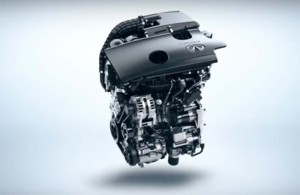
Debuting at the LA Auto Show, the Infiniti QX50 will bring to market the first variable-compression turbo engine.
When Infiniti hinted its new QX50 crossover would be its “most advanced car ever,” they certainly weren’t kidding.
After teasing the new utility vehicle for several weeks we’ve finally gotten a close-up look at the mid-range crossover ahead of its formal debut at the Los Angeles Auto Show on Tuesday and it’s loaded with high-tech features, including Infiniti’s new, semi-autonomous ProPilot driver assistance system. But what’s likely to catch even more attention is the world’s first variable-compression engine.
Dubbed the VC-Turbo, the Japanese luxury brand claims the engine is “the next major step in optimizing efficiency and emissions of the internal combustion engine, literally transforming between power and efficiency on demand.”
First revealed in concept form two years ago, the VC-Turbo is capable of varying its compression ratio between 8:1 to 14:1, that approach allowing it to balance emissions and performance at all times, depending upon driver demand and road conditions. The engine is expected to produce a potent 268 horsepower, well at the extremes for the current flood of turbo-2.0-liter engines coming to market.
(Are you the new Infiniti QX50? For the sneak peek, Click Here.)
Infiniti is by no means the first automaker to try a variable-compression strategy. Other manufacturers who have tinkered with the concept include Lotus, Peugeot and Saab, but this is the first time it is going into mass production, parent Nissan promising we’ll see the VC-Turbo across the Nissan and Infiniti brand line-ups over the next few years.
The approach isn’t simple. It requires a significantly more complex – and costly – design that reportedly has earned Nissan over 400 patents to date. And if it lives up to initial billing it could yield V-6 performance – 0 to 60 in 6.3 seconds with all-wheel-drive – along with the fuel economy of a four-cylinder diesel.
The VC-Turbo engine is likely to get a lot of folks interested in the new QX50 but there are other features that will have them taking an even closer look. Among other things, the Audi Q5 rival is one of the first Nissan/Infiniti models – along with the second-gen Leaf battery-electric vehicle – to get the new ProPilot technology.
Nissan is playing it safe and not billing ProPilot as truly hands-free, but it comes close, a driver just needing to lightly rest a few fingers on the wheel. Then, ProPilot will largely take over accelerating, braking and steering duties on well-marked road.
(Click Here for a review of the all-new Infiniti Q50 sedan.)
Long-time Infiniti fans may remember the QX50 originally appeared under the EX nameplate in 2007. It hasn’t had a real update since 2014 and is thus getting a major makeover for 2019.
“As with all Infinitis,” global design boss Alfonso Albaisa hinted earlier this month, “we have been inspired by our desire to drive, expressed with power and artistry. With this all-new model, inspiration comes from striking the perfect balance between lust and logic. At a glance, seamless and sculptural, getting closer to the car reveals an ingenious blend of proportion and space.”
The 2019 Infiniti QX50 gets the latest iteration of the brand’s rectangular grille, here framed with cats-eye headlamps that flow deep into the front fenders. The design isn’t just more modern, it also is about 6% more aerodynamic, Infiniti claims, which should help deliver another boost to fuel efficiency.
Infiniti has so far released only one image but hints that the interior makeover is an “artistic application of high quality materials and advanced craftsmanship.” Among other things, the back bench slides to offer a choice of more legroom or more cargo space.
(Infiniti goes forward into the past with retro-futuristic Prototype 9. Click Here to check it out.)
Expect to hear more about the 2019 Infiniti QX50 and, in particular, the VC-Turbo engine later this week.

